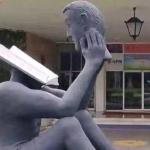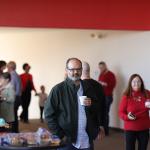By Jonathan Storment (in bold); Josh Ross in regular font.
One of my very good friends Josh Ross recently released his 3rd book Re\Entry. I’ve known about this project for years now because it started as a kind of method preaching/writing project that he went on to help make sense of life after a very tragic event happened in his family.
It’s a project that I’ve been interested in since he first came up with the idea and am very glad to see it finally published. Without giving too much away, but also in order to pique your interest to reading it, I asked Josh to sit down with me and answer a few questions about Re-Entry, and what he was trying to do.
Let’s start with this question: to set a backdrop for the book, you traveled to Barrow, Alaska. Until you told me about the trip, I had never heard of Barrow before. Where is this place?
Barrow is the northernmost town in the United States of America. While there, I took a selfie next to a sign that read, “The northernmost point of the United States.” Cruises don’t go to Barrow. There is no road getting in and out of Barrow. You can only get there by plane or boat; and boats can only get in and out six months out of the year because the ocean freezes. In short…it is way up there!
You were raised in Texas, and have lived in Memphis for a decade, yet you write about it being -65 wind chill. What does that feel like?
I texted Kayci while still on the plane and wrote, “I love you. Tell the boys I love them. I’m going to die!” To say “cold” would be an understatement. Until my trip to Barrow, I had never experienced weather below 0. Never! Five days before the trip, you and I were together in Orlando speaking at the National Conference of Youth Ministers. It was 75 degrees in Orlando. So, within 5 days, I went from 75 to -65. Do the math! One day, my eyelashes froze to my toboggan.
Why go to Barrow? Why not just write about it?
In the spring of 2013 when researching for a sermon I was preparing to preach on Jesus being the light of the world, I came across a NY Times piece that was written in 2005. I was interested in the impact that a lengthy season of darkness may have on an individual and a community. What I discovered in that short article is what took hold of my imagination, and would send me over 3,400 miles away from home, and over 330 miles above the Artic Circle. Here is where it can become depressing. From May 11th to August 1st, the sun doesn’t set. It is continual light. However, the flip side of that is the sunsets on November 18th and doesn’t rise again until January 23rd. That is sixty-five days of darkness.
For places above the Arctic Circle that experience lengthy seasons with no sunlight, it should come as no surprise that depression rates often rise in the winter time. In fact, American Journal of Psychiatry did research recently, and they discovered that winter is a drag for twenty percent of Americans. Even in Memphis, a few winter days of dark clouds and freezing rain, and people go into a funk.
A smaller fraction of Americans suffer from Seasonal Affective Disorder, which is a type of depression stemming from decreased sunlight. Nearly ten percent of Alaskans suffer from the disorder. Severe cases can be debilitating, even prompting thoughts of suicide.
Here is what I found so interesting, and this has become the inspiration of this book. There tends to be a peak season for suicide attempts in Northern Alaska, and most of us would place our bets on it being the wintertime when it is cold and dark.
But it’s not.
Depression & suicide rates actually peek with increasing spring light. They have discovered that there is noticeable tension and difficulty when it comes to reentry into the light. The article ends with this quote, “The problem is with reentry.” One person said, “You don’t have enough energy to make a plan before then.” Another said, “It’s too much trouble. Once the light returns, there’s more energy, but reasoning is still off.”
Now, it’s important to point out that this research wasn’t focused on Barrow, but on the northern towns, cities, and villages in northern Alaska. I would not use the word “depressed” to describe the people of Barrow. My experience there gave me stories about the values that hold people together as they endure seasons of darkness as well as how they anticipate the reappearance of the sun.
Wherever we live, forms of darkness are often due to sin, but that is not always the case. Whether it is moral failure, guilt and shame, decades of apathy, paralyzing fear, greed, racism, depression, attachments, doubt, relational dysfunction, or grief, people everywhere are desperate for the good news of reentry into the light.
Without this information—and my imagination going crazy—my agent Wes Yoder told me that if I wanted to write about it, I had to go. So, I went.
You first told me about this idea and project before you left on your trip, and I remember being so intrigued by it. In Christianity, it seems that at times we place such an emphasis on how people enter into a relationship with God, that we don’t have enough language and theology around reengagement and reentry.
YES! Not that either of us would minimize covenant and that decisions need to be made for Christ, right?
Reality is this, in our lives with God (and in life), we are occasionally hit with tragedies, obstacles, circumstances, and confusion; and how we walk into the future with God isn’t going to look like how we have walked in the past with God. This isn’t necessarily because God has changed, but because circumstances and relationships have changed. What is vital is that the church is coming alongside of people teaching them—and modeling for them—how we develop healthy roots and rhythms that help people navigate seasons of darkness and confusion.
Roots and rhythm? Those are two major sections in your book. Before I ask why, let me ask this first, do you have any rhythm? Can you dance?
Can I dance? Come on man! Of course I can dance. I could have been in the background of a Timberlake video. HA! Kayci and I enjoy dancing every once and while. My boys want to be future beat boys. If you’ve ever heard of dance crews like the Jabbawockeez or Quest Crew, they want to be in those crews one day.
HA! That’s great man. On a more serious note, why the focus on roots and rhythm?
When I got to Barrow, I engaged in conversations with as many people as possible. I met with school administrators, pastors, recovery group leaders, football coaches, principals, counselors, restaurants owners, hotel managers, police officers, and the local librarian. The themes that came up over and over were the ideas of healthy roots and established rhythms. That made a lot of sense to me. As I process it more after the trip to Barrow, I began to develop the idea in greater depth and detail. I’ve become to believe that while roots rarely change in life, rhythms change all the time.
You launched a podcast in conjunction with the book. Tell us more about it.
I did. I didn’t really see myself getting into the podcast game, but the more I processed this idea of reentry, the more I felt compelled to do it. Reentry is more than a book to read, it’s a story to tell. So, every week I launch 2 podcasts, and I bring on guests to discuss how they’ve navigated seasons of darkness, transitions, and confusion in their lives. It has been a lot of fun. It’s called the Reentry Podcast, and I’d love for people to check it out.
This is a great book and project that I think is needed today, especially in American Christianity. We need to ask questions about what it means to walk through grief with God, as well as what it looks like to walk again after it, even if that means Re-Entry with a limp.















